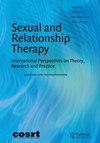撒旦性:理解撒旦崇拜作为性和关系治疗师的多样性问题
IF 1.4
4区 心理学
Q3 PSYCHOLOGY, CLINICAL
引用次数: 3
摘要
现代撒旦主义借用了撒旦作为肉欲之神的神话,随着1966年撒旦教会的成立,它作为一种新的宗教运动开始了。从那时起,该宗教经历了多次分裂和派系,最近的一次是2012年撒旦神庙的形成。尽管在宗教中神秘元素的作用和其他神学或治理分裂的原因有所不同,但撒旦教徒在性解放的共同价值观上是团结的,并将性视为一种真实的自我表达形式,对他们的宗教信仰很重要。将撒旦教概念化为一种非主导的、性积极的宗教,性和关系治疗师应该理解撒旦教徒的性行为如何受益于性解放的宗教信仰,但也可能受到宗教少数派压力的阻碍。讨论了现代撒旦教的历史发展,撒旦教与性别、性取向和关系的交集,以及治疗撒旦教来访者的指导方针。现代撒旦教是一个经常被误解的新兴宗教运动。本文概述了撒旦教的发展,特别关注其与性有关的信仰和实践。为性和关系治疗师提供了如何正确评估和治疗撒旦主义客户的指导方针。本文章由计算机程序翻译,如有差异,请以英文原文为准。
Satanic sexuality: understanding Satanism as a diversity issue for sex and relationship therapists
Abstract Appropriating the mythology of Satan as a god of carnality, modern Satanism began as a new religious movement in 1966 with the founding of the Church of Satan. Since then, the religion has experienced numerous schisms and factions, most recently with the formation of The Satanic Temple in 2012. Despite differences in the role of esoteric elements in the religion and other theological or governance reasons for division, Satanists are united in their shared values of sexual liberation and viewing sexuality as a form of authentic self-expression important to their religious beliefs. Conceptualizing Satanism as a non-dominant, sex-positive religion, sex and relationship therapists should understand how Satanists’ sexuality can benefit from a religious belief in sexual liberation, but can also be hindered by religious minority stress. The historical development of modern Satanism, the intersections of Satanism and gender, sexual orientation, and relationships, and guidelines for therapists working with Satanist clients are discussed. LAY ABSTRACT Modern Satanism is an oft-misunderstood new religious movement. This paper provides an overview of the development of Satanism with special attention to its beliefs and practices relevant to sexuality. Guidelines are presented for sex and relationship therapists on how to appropriately assess and treat Satanist clients.
求助全文
通过发布文献求助,成功后即可免费获取论文全文。
去求助
来源期刊

Sexual and Relationship Therapy
PSYCHOLOGY, CLINICAL-
CiteScore
3.80
自引率
9.10%
发文量
37
期刊介绍:
Sexual and Relationship Therapy is a leading independent journal in its field, well established and internationally recognized. It offers an active, multidisciplinary forum for review and debate across the spectrum of sexual and relationship dysfunctions and therapies. The journal presents original research and best practice and is a vehicle for new theory, methodology, and application. Sexual and Relationship Therapy is edited by a respected international team and publishes contributions from around the world. It is the official journal of the British Association for Sexual and Relationship Therapy (BASRT).
 求助内容:
求助内容: 应助结果提醒方式:
应助结果提醒方式:


